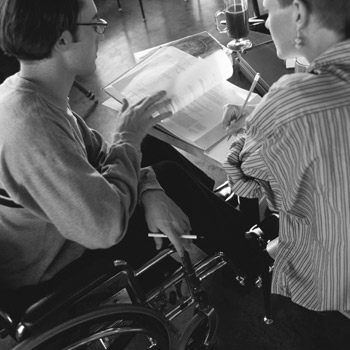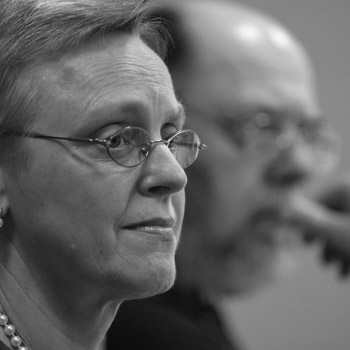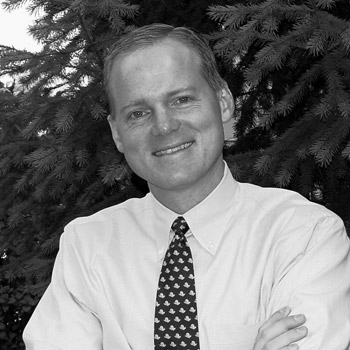As the experiences of three very different theological schools — Austin Presbyterian Theological Seminary, Baptist Theological Seminary at Richmond, and St. Mary’s Seminary and University — illustrate, it takes hard work, patience, strong donor relationships, and in some cases, a bit of board education to grow the endowment.
When Father Robert Leavitt, president-rector of St. Mary’s Seminary and University in Baltimore, Maryland, introduced the idea of raising money to endow faculty chairs, he was surprised by coolness on the part of his board to the plan. After all, endowment wasn’t a new concept for the 214-year-old Roman Catholic institution, which received its first such gift in the early 1980s. But what had caught board members by surprise was the notion of seeking funds for faculty chairs. As Leavitt explains, “The usual tactic is to ask for money in support of bricks and mortar kinds of projects.”
Not to be deterred, St. Mary’s president-rector did some research and then reported the findings to convince the board that his wasn’t such a farfetched notion. Any lingering doubts in board members’ minds were wiped away by the enthusiastic response of donors to the endowment campaign. In 2003, St. Mary’s celebrated the successful completion of five endowed chairs at about $1.5 million apiece. With the addition of another professorship, gifts from the drive now total about $8 million, all from lay benefactors, who, in the words of one donor, believe St. Mary’s is a place that will give priests the training they need to “bring the right vision” to the Church.
“It was simply a matter of my refining the argument,” Leavitt says. “It’s important to read people and know when they’re excited about a project.” And if they’re not, Leavitt advises letting prospective donors know it is okay for them to say no. “You have to acknowledge tension,” he adds. “Sort of make people laugh and relax.”
Caring Enough to Educate the Board
Although board members understand that their involvement is critical to the success of an endowment fundraising effort, asking for money doesn’t come naturally for the majority of trustees. As Robert Spinks, director of development at Baptist Theological Seminary at Richmond (Virginia) has observed, some board members are eager to raise funds, while others do not enjoy that part of their job as much. “I don’t want to ever strong-arm them or heap guilt on them,” he says. “A few board members require hand-holding; others I have to rein in.”
In those places where board members do step up to the fundraising plate, it is usually because the president and development staff make it a priority to provide trustees with training, educational resources, and encouragement. At Austin Presbyterian Theological Seminary (Texas), for example, the chief development officer partners with the president in equipping board members for their responsibility in helping advance the institution. “We try to include an educational component at every board meeting,” Tim Kubatzky, vice president for advancement, reports.
Austin Seminary’s board chair, Elizabeth Williams, adds that the first thing board members are asked to do is examine their individual giving priorities. She states: “It’s important for all board members to be leaders in their giving. It shows that the people responsible for the health of the institution are behind it.”
Mike Allen, a member of the Austin Seminary board and a twenty-year donor to the school, says he knows he has to continue to learn about the seminary in order to communicate its needs to others. As he puts it: “The better I know the school, the more personal my commitment becomes. Austin isn’t just an institution for me. It’s a community of committed Christians — some of whom I know better than others, but all of whom share my love for the seminary.”
Understanding Endowment Donors
When seeking prospects for endowment gifts, development staff and board members are advised to look to the existing donor base. A high percentage of endowment donors made their first gifts to the schools they support through the annual fund. Because endowment gifts represent such a major commitment, it can be a long process working with a donor prospect. As Elizabeth Williams notes, “Endowment fundraising involves mutual respect, trust, and shared goals built over time.”
Current donors are also the people most likely to introduce new friends to a theological school, and such has been the experience at Baptist Theological Seminary at Richmond (BTSR), a young institution with a short, but impressive, history of endowment building. For example, J. Harwood and Louise Cochrane, concerned about the future of their denomination, had already given more than $2 million to the school, which they see as protecting the Baptist theology they hold dear. Their latest gift to the seminary, dubbed the “Cochrane Challenge,” will provide up to $1 million in matching funds for endowment. As a result of the Cochranes’ generosity, other donors, including Ann Beane, have made their own generous gifts to BTSR.
Ten years ago and “in the Lord’s timing,” Beane found herself a widow with an estate to manage. A friend introduced her to the president of BTSR, and she became involved with a building campaign. That led to six years on the seminary board and many more gifts to the school, including one during the “Cochrane Challenge.” “My faith has always been very, very important to me and has sustained me for years,” Beane says. “I wanted to do something that would carry on the ministry of our Lord Jesus Christ.”
When seeking endowment gifts, Fr. Bob Leavitt advises newcomers to the game to manage donor relationships with care. “A certain momentum is developed,” he says. At the same time, he cautions against going back to the same donors too soon. “Smaller institutions have to rethink their market,” Leavitt notes. “You can’t fish in the same waters for too long.”
To her president’s words, Betty Visconage, vice president for advancement at St. Mary’s, adds, “Don’t discourage prospects who may not be able to endow something as large as a faculty chair singlehandedly. Include opportunities for prospects to get involved at a lower level with gifts in support of smaller projects or unrestricted endowment. Flexibility opens the door to a broader range of donors,” she says.
At Austin Seminary, the $25 million Centennial Campaign that began on January 1, 2000, included four categories of endowment gifts: faculty chairs, student scholarships, faculty development, and technology. Reflecting on constituent response to the funding priorities, Kubatzky says, “The seminary has needs, and donors have their interests. It’s important to have a plan that is varied enough to appeal to many different donors and yet also helps the school.”
At the same time, too much variety in a school’s appeal for support can confuse donors, or so notes Bob Fowler, trustee chair of the development committee at BTSR. Fowler further cautions against too narrow restrictions by donors on the intended use of their gifts. “If you have some down years and you’re scrambling to find funds, you still can’t touch the principal amount. For a young school like BTSR, it’s something to consider, because too many restrictions can hinder growth,” he says, but then adds: “Nonetheless, we’ll take every endowment dollar we can get.”
Stewarding Endowment Funds
Securing the gift is just the beginning in building a strong endowment. Indeed, the greater challenge for most schools is to protect and grow endowment funds through careful investment and prudent spending policies — responsibilities that have been especially challenging during the recent downturn in the economy on both sides of the US/Canadian border. “It’s been an interesting time for all endowed institutions, no matter what the size,” states Elizabeth Williams, Austin Seminary’s board chair, who by day is the endowment treasurer at Southern Methodist University.
The good news, according to Tim Kubatzky, is that it appears investments are on the upswing. “The endowment did lose about 20 percent of its value, but it is back up,” he says. Austin Seminary uses an average of the past three years’ totals to calculate its spending percentage, so Kubatzky said he’s looking forward to throwing off a bad year when next year’s percentage is calculated.
Austin Seminary’s board has looked to investment professionals for counsel and has diversified its investments to safeguard its endowment. “We have been watching the endowment very closely and have changed our spending policy in recent years,” Williams explains. “Not spending more, but smoothing out our spending. Long-term we have a goal of trying to reduce the spending rate.”
That’s what a lot of schools are likely to do, says Hugh H. Williamson, III, an Austin Seminary trustee and donor. The former Fortune 500 CEO says the conventional wisdom about spending rates is changing. “Think long and hard about the percentage of the endowment that you’re taking out on a yearly basis,” he advises schools just getting started in the endowment game.
Investment professionals like Williams and Williamson are not uncommon on boards, which is a help to those looking to invest endowment funds. Betty Visconage said St. Mary’s board consults an investment manager but takes a hands-on approach to the school’s portfolio. “Many board members are very savvy investors in their own right, and they bring that experience to the table for us.”
Likewise, Bob Spinks said BTSR’s board asks tough questions of investment advisers. “We’ve got some of the finest business minds on our board,” he claims.
Turning Dreams into Reality
As a school’s endowments begin to grow, it is easier to show prospective donors what’s going on at the institution and where they might fit into the picture. Endowment earnings also help rein in the tyranny of the immediate, enabling everyone — in Kubatzky’s words — to relax and focus more on the spiritual aspects of giving and receiving.
But don’t relax too much, Visconage cautions. “Even if money starts coming in, keep on building endowment,” she says. Those dollars represent faculty members, students, facilities, and limitless tools for ministry. Endowment is, after all, more than a lovely dream. It’s about securing the future of the school and that is board work at its best.
Austin Presbyterian Theological Seminary
Austin, Texas
Founded: 1902
Enrollment: 322
Full-time faculty: 23 Development staff: 6
Earnings from Austin Presbyterian Theological Seminary’s $100 million endowment are crucial to the school’s financial vitality, providing nearly 60 percent of the annual operating budget. It is no surprise then that close to half of the goal in the seminary’s $25 million “Called to Lead: The Centennial Campaign” is designated for various endowment funds: faculty chairs, student scholarships, faculty development, and technology.
Baptist Theological Seminary at Richmond
Richmond, Virginia
Founded: 1989
Enrollment: 325
Full-time faculty: 13
Development staff: 3
From the beginning, endowment building has been a priority for the leadership team at Baptist Theological Seminary at Richmond. Despite the high costs of program start-up, including the purchase and renovation of several buildings, about $6 million has been added to the school’s endowment over the past 15 years. When the current three-year, $11 million campaign is completed, that amount will have grown by $5 million or so.
St. Mary’s Seminary & University Baltimore, Maryland
Founded: 1791
Enrollment: 287 (67 studying for the priesthood and 220 in the Ecumenical Institute)
Full-time faculty: 14
Development staff: 2
When Father Robert Leavitt assumed the position of president-rector at St. Mary’s Seminary and University in the early 1980s, gifts in support of endowment were a relatively new idea for the school’s board and constituency. Twenty-five years later, a focus on endowment is a mainstay of St. Mary’s fundraising program. This past fall, the community celebrated the latest fruit of its endowment building efforts: five newly endowed faculty chairs.
Read the other articles in the New Year 2005 fundraising series:
Make this the year
Some short thoughts on long term financial security
The power of peer learning: Summary report from an eight-school study




























